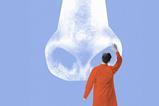How the scientific revolution made it culturally permissible to exploit the environment

The climate change emergency has brought forward the need to rethink how we humans interact with the environment. Should we be allowed to extract natural resources from the earth to accommodate our energy needs? Should we cut down forests to plant vegetables or raise cattle? Should we use plastic packages and then throw them away in the sea? While technological advances provide sustainable ways to tackle such matters, any reply we give to these questions is also largely determined by how we understand our relation to nature. For any progress to be made around climate change, we have to re-address how we perceive (and should perceive) this relation.
I say ‘re-address’ because even though climate change is a modern-day problem – perhaps even the defining issue of our times – philosophers have been questioning how humans relate to nature for quite some time.
Scientific practice, being directly occupied with understanding nature, represents an extremely informative source to understand not only the practical ways humans interact with nature, but also the accepted norms that guide and restrict this relation. In particular, there is one scientific event that is taken to have greatly determined how humans treat the environment today: the Scientific Revolution.
Throughout the 16th–18th centuries, the series of events that we now call the Scientific Revolution marked the emergence of science as we know it: empirical observation and experimentation became essential means for testing hypotheses. Major advances in our understanding of nature also occurred, including the realisation that the earth is not the centre of the universe. Moreover, according to ecofeminist philosopher Carolyn Merchant, a major shift in how people perceived their relation to nature took place during that period.1
Seneca and Ovid argued that metallurgy and mining shouldn’t be permissible as they represented forms of abuse towards nature
Prior to the Scientific Revolution, the most dominant image of nature in Western culture (and also beyond) represented the earth as a living organism, with organs of different functions all serving the whole. For example, Leonardo da Vinci referred to rivers as the veins of earth, circulating like the blood system from the mountains to the seas. Nature was also often identified with a mother; one that nourishes humans and one that humans have the duty to respect. In this context, philosophers such as Seneca and Ovid argued that metallurgy and mining shouldn’t be permissible as they represented forms of abuse towards nature.
Among those groups that understood nature as a living being were the precursors of chemists: alchemists. Interestingly, alchemists diverged from the standard understanding of ‘mother-nature’ as they believed that nature is androgynous; it encompasses both the feminine and the masculine.2 In their view, the masculine and the feminine constitute necessary elements in order to achieve, among other things, the transmutation of metals to gold and the philosopher’s stone!
With the scientific revolution all this changed radically. Francis Bacon spelled out a new ethical system where nature was no longer perceived as a living being to be revered or respected, but rather as a machine to be manipulated and taken advantage of for the benefit of humankind. Nature became a configuration of passive lifeless matter; something people should dominate via technology. It became morally permissible – if not expected – to take advantage of natural resources to achieve economic, social and scientific progress.
The expression of this mentality can be found in early chemistry as well. Robert Boyle argued that ‘there are two very distinct ends that men may propound to themselves in studying natural philosophy. For some men care only to know nature, others desire to command her.’3 This idea was not unique to Boyle. It rather reflects a general attitude that was expressed by proponents of the so-called mechanistic philosophy, which purported that all natural phenomena are the result of nothing other than the collision and motion of chunks of matter.
None of this implies that Bacon or Boyle would resist calls to protect the environment today (I’d say rather the opposite!). Nevertheless, unpacking this episode illuminates how our attitude towards nature is intertwined with our culture and is shaped by the often implicit assumptions and beliefs we have been raised to accept. More importantly, it shows why it has become culturally permissible that nature is manipulated and exploited, and may even explain why it is so difficult to collectively agree on how to stop harming it. By realising this, perhaps we will finally see that a solution to the climate change emergency does not merely come down to creating sustainable technological solutions; it also requires a radical re-conception of our place in the world.
None of this implies that Bacon or Boyle would resist calls to protect the environment today (I’d say rather the opposite!). Nevertheless, unpacking this episode illuminates how our attitude towards nature is intertwined with our culture and is shaped by the often implicit assumptions and beliefs we have been raised to accept (Chemistry World, October 2021, p70). More importantly, it shows why it has become culturally permissible that nature is manipulated and exploited, and may even explain why it is so difficult to collectively agree on how to stop harming it. By realising this, perhaps we will finally see that a solution to the climate change emergency does not merely come down to creating sustainable technological solutions; it also requires a radical re-conception of our place in the world.
References
1 C Merchant, The death of nature: Women, ecology, and the scientific revolution, Harper Collins, 1980
2 E F Keller, Reflections on gender and science, New Haven: Yale University Press, 1995
3 R Boyle, The Works of the Honourable Robert Boyle: In Five Volumes. To which is Prefixed the Life of the Author (Vol. 1), A Millar, 1774

















No comments yet